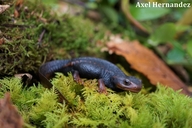|
Tylototriton shanorum Nishikawa, Matsui & Rao, 2014
Taunggyi Crocodile Newt Subgenus: Tylototriton | family: Salamandridae subfamily: Pleurodelinae genus: Tylototriton |
| Species Description: Nishikawa K, Matsui M, Rao D 2014 A new species of Tylototriton (Amphibia: Urodela: Salamandridae) from central Myanmar. Nat Hist Bull Siam Soc 60: 9-22. | |
 © 2019 Axel Hernandez (1 of 1) |
|
|
Author: Axel Hernandez Tylototriton shanorum NISHIKAWA, MATSUI, & RAO 2014
Diagnosis and taxonomyThe holotype (CAS 230940), an adult male, was collected in Taunggyi Township, Shan State, Myanmar (20° 48′ 28.5″N, 97°02′ 45.1″E, 1,457 m a.s.l.) in August of 2002. Its name relates to the Shan State in which it was discovered. This species forms a clade with T. himalayanus that is well separated from the other southern groups. It has a long trunk and is far more robust than both topotypic T. verrucosus and T. uyenoi, and is one of the largest species of the genus Tylototriton. Females can grow to a total length of 17.6 cm and are slightly stockier than males that reach a larger maximum TL of 18.7 cm. The skin is warty with fine granules. The muzzle is remarkably pronounced, truncated and warty (unlike T. uyenoi and T. verrucosus), the head wide and angular, depressed, and slightly sloping when viewed in profile. The limbs are long and thin. The vertebral ridge is narrow and weakly segmented. The 13 - 14 dorsolateral glandular warts are fairly prominent (NISHIKAWA et al. 2014). The dorsal ground color tends to be dark brown on the dorsal side, with reddish orange on the vertebral ridge, transverse warts, limbs and tail, and brown spots on the head and parotoids. The ventral region, upper and lower lips, tips of the fingers, and lower front portion and ventral side of the tail are yellowish and unmarked. This character state is very similar to that in T. uyenoi, only that its colors are much duller; as in T. shanorum, they vary between individuals.Morphological variation is known to exist in the northern populations and distinguishing the species of the supraspecies verrucosus on the basis of morphological characters alone is all but easy. The populations in Kachin State in northern Myanmar represent a form currently known as Tylototriton cf. shanorum "Kachin" that is morphologically different and seems to include the Arunachal Pradesh type (HERNANDEZ 2016b). Another light yellow population with a truncated snout was observed by the author on the Myanmar-Chinese border in May of 2012 and maybe another new form from Myanmar deserving of a new status. Moreover, the specimens of T. verrucosus that were imported in large numbers into Europe from the 1960’ through the 1980’ correspond to the taxon T. shanorum and Indian types. Many specimens of this and related forms were used for medical and laboratory experiments such as research on embryogenesis (FERRIER & BEETSCHEN 1973, FERRIER 1974). Thus, these newts were easily found in the terrarium animal trade under the name T. verrucosus without clear locality data, which kept various European zoos from establishing conservation breeding projects (HERNANDEZ 2015b, 2016a, b) in spite of an unprecedented decline (NISHIKAWA et al. 2014, PHIMMACHAK et al. 2015, HERNANDEZ 2015a, 2016a,b). DistributionAside from the type locality at Taunggyi Township, Shan State, Myanmar, no other localities are known at this stage, but the mountainous region could well harbor more populations.Habitat, ethology and ecologyT. shanorum lives at around 1,400 m a.s.l. in densely vegetated mountains. The habitat in the Taunggyi Mountains is characterized by a humid subtropical climate and distinct seasons. Temperatures here do not exceed 28.0 °C in summer and may drop to 10.0 °C in winter.ReproductionReproduction starts in May and June as in other species of this genus.Status, threats and conservationTylototriton shanjing was a common species in the past and is still present in the wild. It has been used in traditional Chinese medicine in the form of soup or powder mixed with food for a long time. Several specimens were sold in the pet trade in the 1990/2000’s in Japan, North America and Europe, which suggests that some poaching for this purpose is still ongoing. Considering the small known distribution range, all this might be a real threat to its continued existence, in particular as it has no conservation status at present.Complete BibliographyFeedback or comments about this page.
Citation: AmphibiaWeb. 2024. <https://amphibiaweb.org> University of California, Berkeley, CA, USA. Accessed 20 Apr 2024. AmphibiaWeb's policy on data use. |


 Map of Life
Map of Life